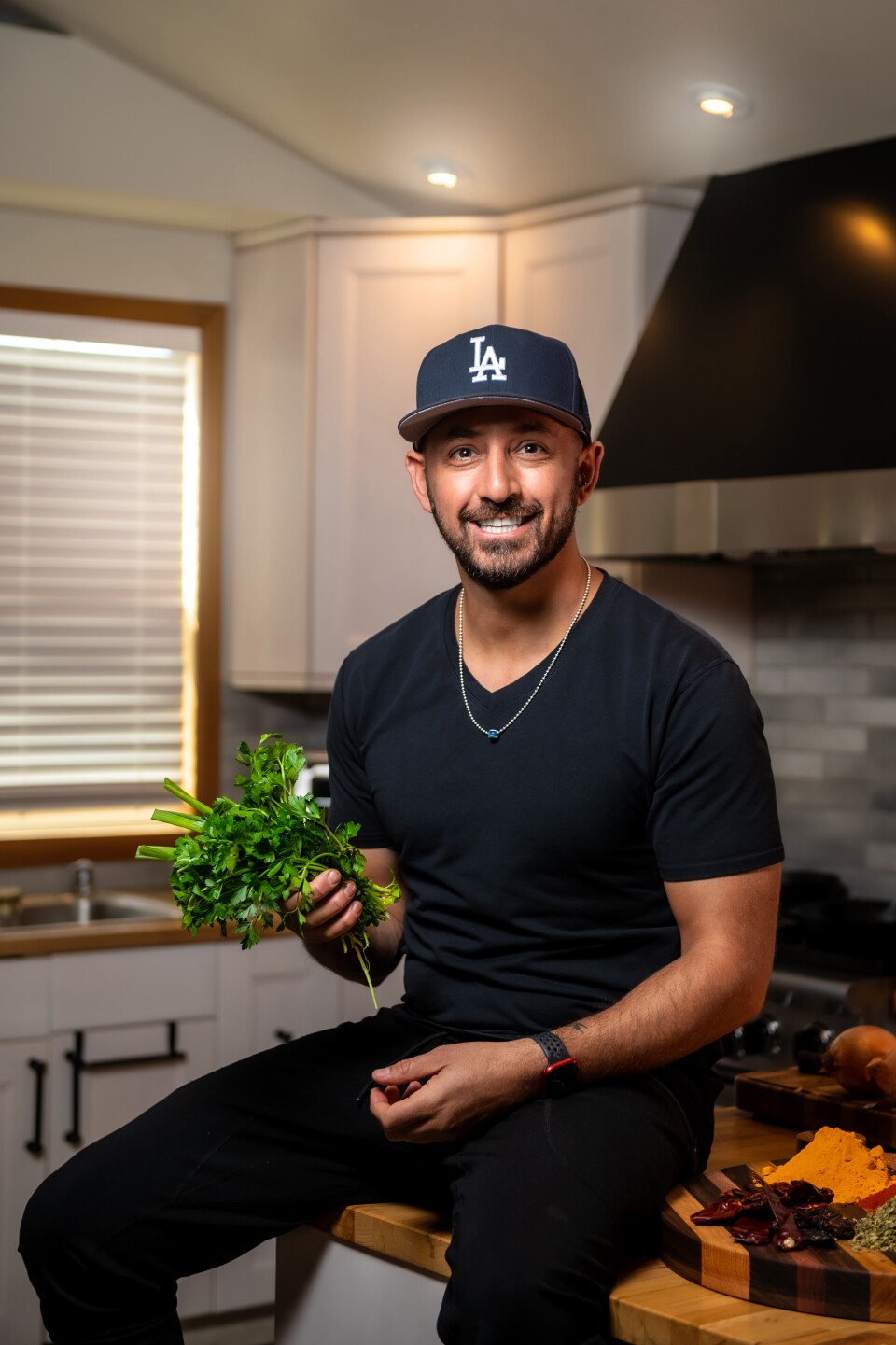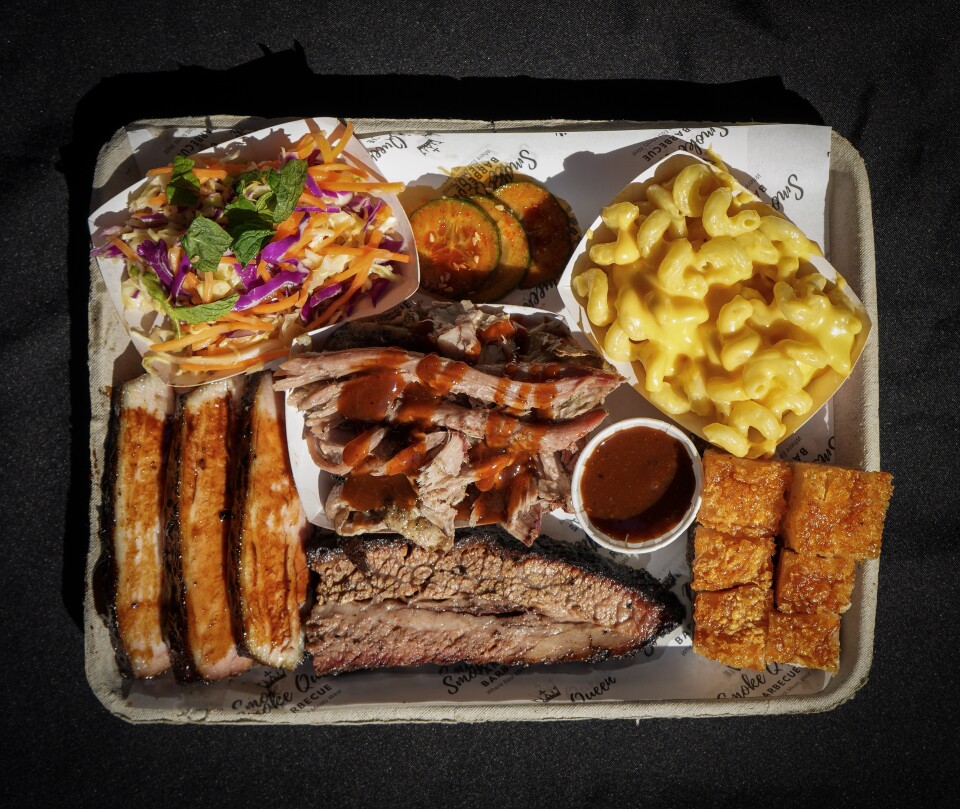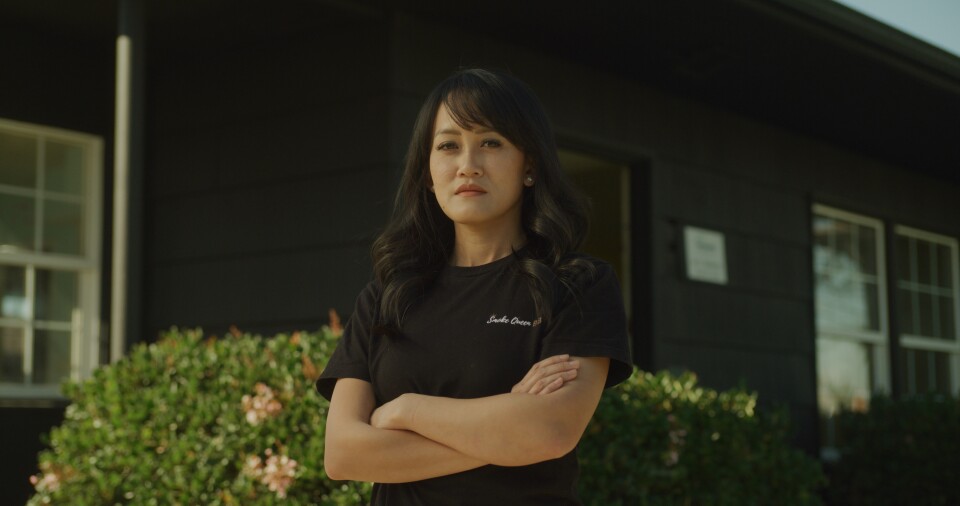This story is free to read because readers choose to support LAist. If you find value in independent local reporting, make a donation to power our newsroom today.
The Main Ingredient Of Barbecue In LA Is Community

Picture this: a scene I've watched often as an Armenian American who's attended barbecues since childhood.
In a park, a cheerful scream of children rises as a light smoke fills the air. Picnic tables are covered with white linen, where women peel the charred skin off the vegetables.
Next to them, a group of men rotate metal skewers with carefully arranged equal pieces of pork, chicken, and beef on a mangal — a grill made for Armenian-style barbecue.
A pungent smell of charred meat and the piquant fragrance of onion and pepper rises from the grill.
The conversation touches on the latest political developments in Armenia, as some complain about the current government and others are protective.
Often, voices rise, but someone quickly suggests a toast, and all are friends around the sparkly fire once again.
To cook over an open fire
“Armenians call their style of barbecue ‘khorovats’, [which] translates into ‘cook over open fire’," says Ara Zada, chef and co-author of Lavash, a cookbook about traditional Armenian food and recipes.

“It’s more like a dance around the mangal — to know where to put meat and vegetables, where the charcoal is,” Zada adds. ‘’Your meat goes on at a different time, your chicken, your vegetables. And as you’re putting it on, moving it around on the coal itself. ”
Commonly, vegetables are cooked fast on the open fire, while the meat is added later to be charred when the fire is low, giving it its smokiness.
During Zada’s visits to Armenia, where he traveled to different villages and cities, he learned about the dishes his ancestors cooked for thousands of years and his country's barbecue history.

“In the north of Armenia, I met a barbecue champion who won most of his competitions by taking rose stems and laying them over the coals. You got little touches into the meat as it was grilling,” remembers Zada.
Armenians take khorovats so seriously that they hold festivals and contests around it — and have even dedicated a song to it, which is often played at weddings and other major happenings.
The United States of barbecue
“Barbecue is the quintessential American food,” says Jim Auchmutey, the author of Smokelore, a Short History of Barbeque in America. In his book, Jim Auchmutey tells the story of the United States through the lens of barbecue, from the colonial era, slavery, the Civil War, and immigration to the present day.
But what is American barbecue? And how did it become American?
Auchmutey has the perfect definition: everyone who uses fire and meat in this country, wherever they come from in the world.
“The way the American barbecue tradition started was because of the mingling of different cultures,” he says, pointing to the arrival of European settlers and enslaved Africans.

Since then, immigrants have brought their own food cultures and grilling techniques and introduced them to others. Today, new styles are born in backyards and parking lots, developed by family pitmasters and skilled chefs.
“They are all the different branches of the family tree of barbecue. These different grilling styles are just being generalized under the word barbecue since that’s the word known in the United States,” says Auchmutey.
“It’s coming around as a full circle,” he says.
Twisting Traditions
“Everyone at one point, it doesn’t matter if you’re white, Black, Native American, Chinese, Japanese, someone killed an animal, took a hunk of meat, put it on a stick and put it on fire. And it tasted so much better!” says Logan Sandoval, the chef and co-founder of Zef BBQ, an underground popup that started from Logan’s garage in Simi Valley during the pandemic.
Sandoval has had an extensive career as a chef with Hyatt Hotels and Resorts. He is one of the participants in the Netflix original series “Barbeque Showdown,” a competition where contestants showcase their grilling skills and techniques in non-traditional settings.

“To me, barbecue is anything that can go into the fire. There is a fire and food; you just need to make it on your own," he says. "I want to make food that makes me feel good, food that I want to eat."
The most important part, he says, is feeding food he loves to other people.
Sandoval learned about flavors and how to properly use spices from his step-grandmother, an Apache woman. She made everything from scratch: tamales, enchiladas, Spanish rice.
“I was 10 or 11 the first time I started having a fascination towards food and realized that food can be so much more than a tuna casserole or hamburgers,” he says.
"It’s not just cuisine. It’s a culture in which we infuse our heritage,”
Hot chiles, sauces, moles, and other vibrant flavors help Zef BBQ stand out, like the pork belly burnt ends, boldly seasoned with Chinese five spice and Sichuan peppercorns, and the short rib curry, soaked in house-made panang curry with the delicate taste of cinnamon.
Barbecue taught Sandoval a lot about patience with cooking, which can last up to 14 hours: “There are no shortcuts. If you want to do it the right way, there are no shortcuts.”
He shows his daughter, who will soon be 7 years old, how to build fire and how not to be afraid of fire.
“In this age of instant gratification, when we get everything from Doordash, McDonald's and others, I am trying to teach her that good food comes from good preparation and good technique. We want her to grow up and learn to care for herself.”
East meets West
American barbecue is often defined by its origin, whether coming from Memphis, Texas, or Kansas.
But Winnie Yee-Lakhani, known as the Smoke Queen, is crafting a new narrative by adding her own style of Asian barbecue. With her “When East meets West” slogan, Yee-Lakhani introduces the flavors she grew up with, including cumin, garlic powder, paprika, and sesame oil, in her non-traditional Texas-style smoked brisket and Cantonese crispy skin pork belly every Sunday at Smorgasburg.

“The barbecue is very primitive, very romantic. It’s a cooking technique that involves the whole community," she says. "Anytime there is a gathering, everybody’s thinking about cooking outside. It’s not just cuisine. It’s a culture in which we infuse our heritage."
Yet, she adds, in her native Malaysian-Chinese cuisine, there’s not a lot of slow cooking involved. Most food is “hot and fast,” she laughs.
Yee-Lakhani, who used to run a franchise of restaurant chains operating inside Hilton hotels, got her start during the pandemic when all the restaurants she used to work with were shut down.
She decided to stretch herself by exploring barbecue and learning smoking techniques. With many trials and errors she finally learned how to barbecue using her Chinese and Malaysian heritage and the spices she used to have in her own kitchen.
She says going into the barbecue business, she’s encountered various stereotypes — one being a woman, the other being Asian.
“Doing American barbecue is very niche. I was always afraid that the fact that I was Asian would hurt my business. But I overcame that," she says. "It’s been three years now. I am also receiving a lot of comments for doing a barbecue from other women who think that it’s a man’s thing.”
This fall, Winnie’s long-awaited restaurant in Garden Grove will debut. In this house-converted kitchen, she will offer the hospitality and traditions prevalent in her cooking. With this project, Winnie hopes to recreate the model of the similar restaurants she’s been to in her homeland in Malaysia, where everyone is warmly welcomed, treated as a family and offered homemade food.
“In a way, this all comes back to what’s important in the barbecue community. Preserving the history, architecture, and design of that neighborhood will definitely be worth it,” Yee-Lakhani adds.










